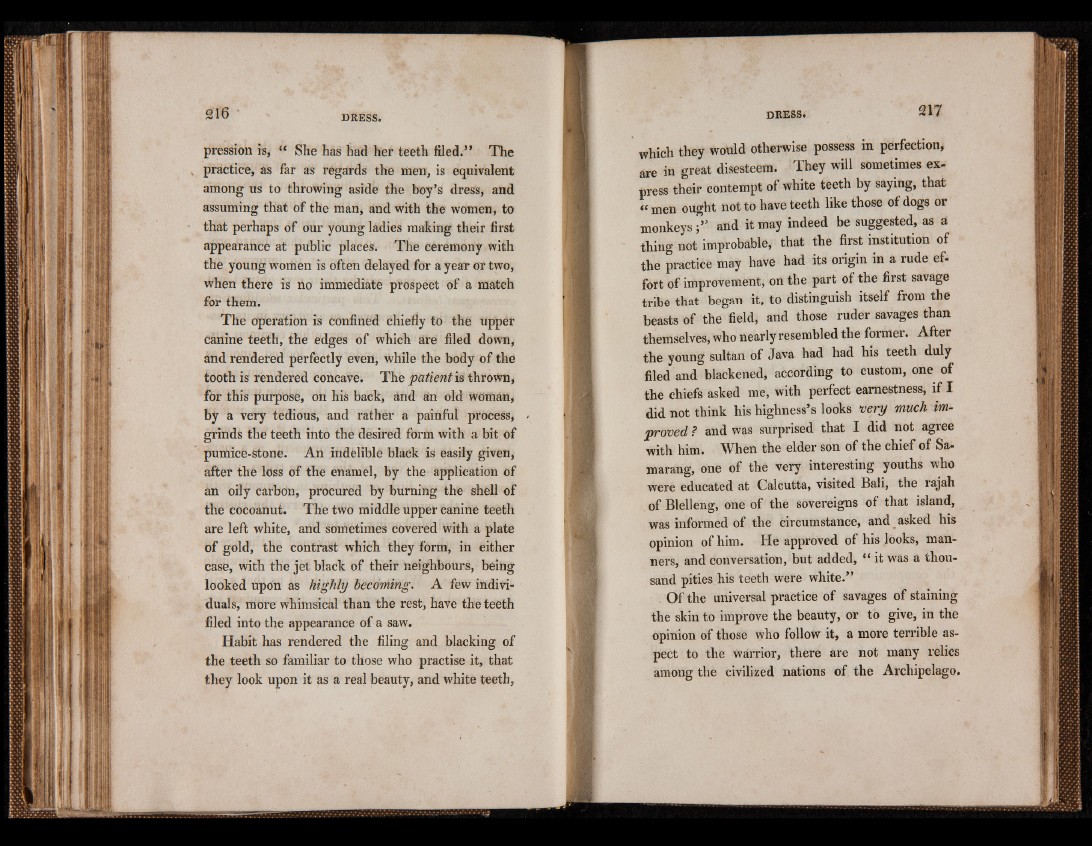
pression is, “ She has had her teeth filed.’* The
practice, as far as regards the men, is equivalent
among us to throwing aside the boy’s dress, and
assuming that of the man, and with the women, to
that perhaps of our young ladies making their first
appearance at public places. The ceremony with
the young women is often delayed for a year or two,
when there is no immediate prospect of a match
for them.
The operation is confined chiefly to the upper
canine teeth, the edges of which are filed down,
and rendered perfectly even, while the body of the
tooth is rendered concave. The patient is thrown,
for this purpose, on his back, and an old woman,
by a very tedious, and rather a painful process,
grinds the teeth into the desired form with a bit of
pumice-stone. An indelible black is easily given,
after the loss of the enamel, by the application of
an oily carbon, procured by burning the shell of
the cocoanut. The two middle upper canine teeth
are left white, and sometimes covered with a plate
of gold, the contrast which they form, in either
case, with the jet black of their neighbours, being
looked upon as highly becoming. A few individuals,
more whimsical than the rest, have the teeth
filed into the appearance of a saw.
Habit has rendered the filing and blacking of
the teeth so familiar to those who practise it, that
they look upon it as a real beauty, and white teeth,
which they would otherwise possess in perfection,
are in great disesteem. They will sometimes express
their contempt of white teeth by saying, that
<< men ought not to have teeth like those of dogs or
monkeys;” and it may indeed be suggested, as a
thing not improbable, that the first institution of
the practice may have had its origin in a rude effort
of improvement, on the part of the first savage
tribe that began it, to distinguish itself from the
beasts of the field, and those ruder savages than
themselves, who nearly resembled the former. After
the young sultan of Java had had his teeth duly
filed and blackened, according to custom, one of
the chiefs asked me, with perfect earnestness, if I
did not think his highness’s looks very much improved
? and was surprised that I did not agree
with him. When the elder son of the chief of Sa-
marang, one of the very interesting youths who
were educated at Calcutta, visited Bali, the rajah
of Blelleng, one of the sovereigns of that island,
was informed of the circumstance, and asked his
opinion of him. He approved of his looks, manners,
and conversation, but added, “ it was a thousand
pities his teeth were white.”
i Of the universal practice of savages of staining
the skin to improve the beauty, or to give, in the
opinion of those who follow it, a more terrible aspect
to the warrior, there are not many relics
among the civilized nations of the Archipelago.